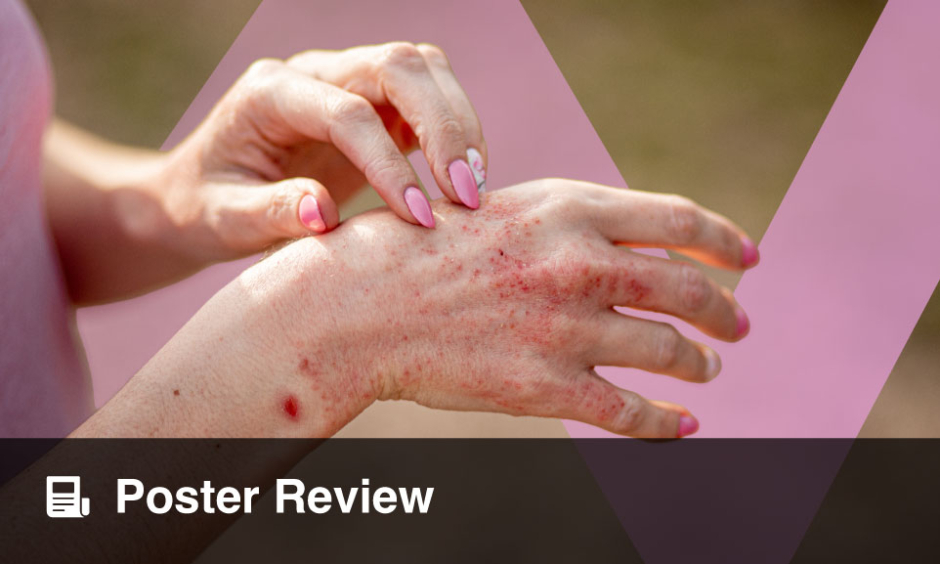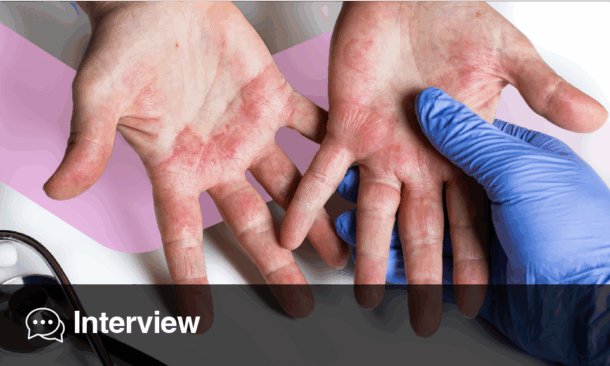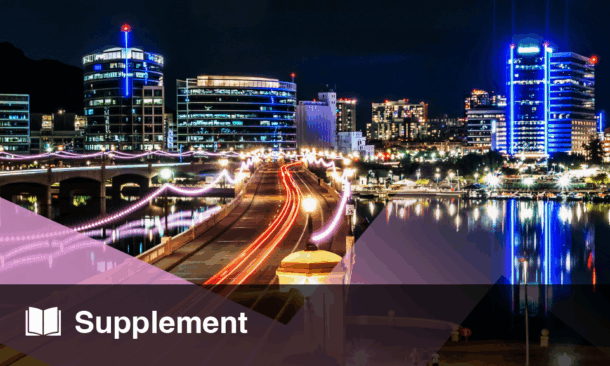Presenters: Richard G. Langley,1 Andrew Blauvelt,2 April Armstrong,3 Ernesto J. Muñoz-Elías,4 Kristian Reich5
- Dalhousie University, Halifax, Canada
- Oregon Medical Research Center, Portland, Oregon, USA
- University of Southern California, Los Angeles, California, USA
- Janssen Research & Development LLC, La Jolla, CA/Spring House, Pennsylvania, USA
- Translational Research in Inflammatory Skin Diseases, Institute for Health Services Research in Dermatology and Nursing, University Medical Center Hamburg-Eppendorf, and Skinflammation® Center, Hamburg, Germany
Disclosure: Prof Langley has served as principal investigator for and is on the scientific advisory board or served as a speaker for AbbVie, Amgen, Boehringer Ingelheim, Celgene, Janssen, Leo, Lilly, Merck, Novartis, Pfizer, and UCB. Dr Armstrong has served as a research investigator and/or consultant to AbbVie, Janssen, Lilly, Leo, Novartis, UCB, Ortho Dermatologics, Dermira, Sanofi, Regeneron, BMS, Dermavant, and Modernizing Medicine. Dr Blauvelt has served as a scientific advisor and clinical study investigator for AbbVie, Aclaris, Akros, Allergan, Almirall, Allergan, Amgen, Arena, Athenex, Boehringer Ingelheim, Bristol Myers Squibb, Celgene, Dermavant, Dermire Inc., Eli Lilly and Company, FLX Bio, Forte, Galderma, Genetech/Roche, GlaxoSmithKline, Janssen, LEO Pharma, Meiji, Merck Sharp & Dohme, Novartis, Pfizer, Purdue Pharma, Regeneron, Revance, Sandoz, Sanofi Genzyme, Sienna Pharmaceuticals, Sun Pharma, UCB Pharma, Valeant, and Vidac; and as a paid speaker for AbbVie, Regeneron, and Sanofi Genzyme. Prof Reich has served as advisor and/or paid speaker for and/or participated in clinical trials sponsored by AbbVie, Affibody, Almirall, Amgen, Biogen Idec, Boehringer Ingelheim, Celgene, Covagen, Forward Pharma, Fresenius Medical Care, Galapagos, GlaxoSmithKline, Janssen Cilag, Kyowa Kirin, LEO Pharma, Lilly, Medac, Merck Sharp & Dohme, Miltenyi, Novartis, Ocean Pharma, Pfizer, Samsung Bioepis, Sanofi, Takeda, UCB Pharma, Valeant, XBiotech and Xenoport. Dr Muñoz-Elías is an employee of Janssen Research & Development LLC.
Support: The posters, presentations, and publication of this article were funded by Janssen. The views and opinions expressed are those of the speakers and not necessarily of Janssen.
Citation: EMJ Dermatol. 2019;7[Suppl 10]:10-16; DOI/10.33590/emjdermatol/10314045. https://doi.org/10.33590/emjdermatol/10314045.
Presentation Summaries
Guselkumab was the first monoclonal antibody targeting the p19 subunit of IL-23 (IL-23p19) to be approved for the treatment of psoriasis. The registrational trials VOYAGE 1 and 2 established the efficacy and safety profile of guselkumab to Week 48 and demonstrated the superiority of guselkumab over placebo and adalimumab. A 5-year, open-label extension phase of both trials is currently ongoing. The poster and oral presentations reviewed here represent the latest data to emerge from the guselkumab clinical trial programme in psoriasis, as presented at the 28th European Academy of Dermatology and Venereology (EADV) Congress. The ECLIPSE study was the first head-to-head trial between guselkumab and the IL-17A inhibitor secukinumab. Both agents were the first to be approved in their respective class with proven efficacy for the treatment of moderate-to-severe psoriasis but, until now, no direct comparisons were available to assist clinical decision making. Together with efficacy and safety, ECLIPSE also sought to understand the differential impact of IL-23 versus IL-17 inhibition on the immune profile of psoriatic skin and effector cytokines, providing insights into their respective mechanisms of action. Switching focus to the long term, the latest 3-year safety data from VOYAGE 1 and 2 are now available to accompany the established 3-year efficacy profile, providing unprecedented insights into the long-term response and tolerability of guselkumab for the treatment of psoriasis.
Overview of the ECLIPSE Study
The biologic era dawned in dermatology with the introduction of TNF antagonists. Since then, dermatologists have added the IL-12/23 p40 (subunit (IL-12/23p40) inhibitor ustekinumab to their armamentarium, and, more recently, monoclonal antibodies targeting IL-17, as well as IL-23.1
Comparator trials have established the superiority of IL-23 inhibition over TNF inhibition for treating psoriasis and demonstrated the favourable response rates attained by IL-17A inhibition and the selective inhibition of the IL-23 p19 subunit (IL-23/p19) compared with IL-12/23p40.1
The launch of novel IL-17A and IL-23p19 inhibitors has seen further evolution of the treatment paradigm with higher and more durable response rates, but until now no data were available to carry out meaningful comparisons of these latest targets and inform clinical decision making.1
ECLIPSE is the first head-to-head comparator trial of guselkumab and secukinumab, monoclonal antibodies that inhibit IL-23/p19 and IL-17A, respectively, in moderate-to-severe psoriasis. This randomised, Phase III trial was carried out in nine countries across Europe, North America, and Australia, and recruited adult patients with moderate-to-severe, plaque-type psoriasis who were candidates for systemic or phototherapy.1
In brief, patients were randomised 1:1 to receive 100 mg guselkumab (n=534) at Weeks 0, 4, and then every 8 weeks through Week 44, or 300 mg secukinumab (n=514) at Weeks 0, 1, 2, 3, 4, and then every 4 weeks through Week 44. Subjects in the guselkumab group also received placebo injections to mimic the secukinumab dosing schedule and maintain the double-blinding. Patients were followed up until Week 56, and the primary endpoint of the trial was the proportion of patients who achieved a response of Psoriasis Area and Severity Index (PASI) 90 at Week 48. This is a marked difference from prior comparator trials which have tended towards short-term outcomes.1
Consistent Responses to Guselkumab by Disease Region at Week 48 in the Treatment of Moderate to Severe Psoriasis: Results from the ECLIPSE Trial
Professor Richard G. Langley
This subgroup analysis of the ECLIPSE trial evaluated efficacy by body region components of PASI for patients who had a score >0 for the relevant component: specifically, head, trunk, upper extremities, and lower extremities. The baseline demographics and mean baseline PASI scores did not significantly differ between the two treatment groups in that the mean PASI score was 20, representing the moderate-to-severe disease experienced by the patient population.2
Guselkumab demonstrated superior efficacy at Week 48 with 84.5% (451/534) of patients achieving PASI 90 versus 70.0% (360/514) of patients in the secukinumab group (p<0.001). This represents a difference of almost 15 percentage points between the treatment groups. Furthermore, higher proportions of patients who received guselkumab reported improvements of ≥90% and 100% in PASI body region component scores at Week 48 compared with those who received secukinumab. This was consistent for all regions measured; ≥90% PASI improvement in the guselkumab and secukinumab groups were reported by 85.0% versus 77.1% of patients for the head (Δ7.9), 86.7% versus 80.0% for the trunk (Δ6.7), 81.8% versus 66.9% for the upper extremities (Δ14.9), and 81.1% versus 66.9% for the lower extremities (Δ14.2), respectively. The proportion of patients with 100% improvement in PASI ranged from 74.9% and 61.4% (lower extremities) to 84.4% and 77.7% (trunk) in the guselkumab and secukinumab groups, respectively. Again, the greatest differences observed in 100% PASI improvement were observed between the upper and lower extremities (Δ16.2 and Δ13.5, respectively).2
The key safety findings were similar between treatment groups and consistent with those reported for their respective registrational trials. Of note, patients who received secukinumab experienced a higher rate of superficial candida albicans infections and tinea infections (5.7% and 4.5%, respectively), compared with those who received guselkumab (2.2% and 1.7%, respectively).1,2
Efficacy of Guselkumab versus Secukinumab in Patients with Moderate-to-Severe Plaque Psoriasis in Subgroups Defined by Previous Psoriasis Medication History: Results from the ECLIPSE Study
Doctor Andrew Blauvelt
Dr Blauvelt and colleagues expanded the efficacy analysis of ECLIPSE by evaluating the response to guselkumab and secukinumab in subgroups of patients defined by their treatment history at baseline. Patients were grouped by those who had received prior phototherapy, non-biologic systemic therapy, or biologic therapy. Prior biologic therapies included TNF inhibitors, IL-12/-23 or IL-23 inhibitors, and IL-17 inhibitors, with the exclusion of patients who had received prior guselkumab and secukinumab.3
The psoriasis medication history was comparable between the two groups at baseline. The majority of patients had received prior topical agents, approximately half had undergone phototherapy, and just over half had received non-biologic systemics. Twenty-nine percent of patients had received prior biologic therapy, of which TNF inhibitors were the most common, followed by IL-17 inhibitors and IL-12/23 or IL-23 inhibitors. Finally, 37% were naïve to non-biologic systemic and biologic therapies.3
Treatment with guselkumab consistently resulted in numerically greater proportions of patients achieving PASI 90 and 100 at Week 48 compared with secukinumab, regardless of previous medication. In the guselkumab group, PASI 90 responses ranged from 73.3% in patients who had received prior IL-12/23 or IL-23 inhibitors to 85.5% in those who had received prior IL-17 inhibitors. This compared with 56.8% in patients who had received prior IL-12/23 or IL-23 inhibitors to 68.6% in those who had received prior phototherapy or non-biologic systemic therapy in the secukinumab group. There was a difference of 17 percentage points in PASI 90 response between treatments in the subgroup who had received prior biologics (81.4% in patients who received guselkumab versus 64.4% for those who received secukinumab). The greatest differences were noted in patients who had previously received TNF inhibitors (76.8% and 58.8% in the guselkumab and secukinumab groups, respectively; Δ18.0) and prior IL-17 inhibitors (85.5% and 68.1%, respectively; Δ17.4). The smallest difference occurred in patients who had received non-biologic systemic therapy (83.0% and 68.6% in the guselkumab and secukinumab groups, respectively; Δ14.3).3
A similar pattern was noted for PASI 100 responses, with the greatest difference occurring in the subgroup who had received prior TNF inhibitors (57.3% and 42.4% in the guselkumab and secukinumab groups, respectively; Δ15.0). The lowest differences in PASI 100 was observed in patients who had received prior phototherapy or IL-17 inhibitors (Δ9.0 and Δ7.2, respectively).3
An Investigator’s Global Assessment (IGA) score of 0 followed the same trend, with consistently greater proportions of patients who received guselkumab achieving IGA 0 compared with those who received secukinumab. Approximately 60% of patients who received guselkumab achieved IGA 0 regardless of psoriasis treatment history, compared with 40–52% of those who received secukinumab. The greatest differences were observed in those who had received prior IL-12/23 or IL-23 inhibitors (Δ16.9) and TNF inhibitors (Δ15.0).3
Guselkumab Demonstrates Greater Efficacy Compared to Secukinumab Across Body Weight Quartiles and Body Mass Index Categories: Week 48 Results from the ECLIPSE Trial
Doctor April Armstrong
It is known that patient body weight and BMI can impact the efficacy of fixed-dose biologics for psoriasis, to which Dr Armstrong led a further evaluation of the efficacy data from ECLIPSE with analysis of responses to guselkumab and secukinumab by body weight quartiles and BMI.4
There were no body weight criteria for enrolment into ECLIPSE and these post hoc analyses were carried out with the following baseline categories: body weight quartile 1 (Q1) ≤74 kg, Q2>74 to ≤87 kg, Q3>87 to ≤100 kg, and Q4>100 kg; and BMI normal (<25 kg/m2), overweight (≥25 to <30 kg/m2), and obese (≥30 kg/m2). Patient numbers were roughly equal between each category for both treatment groups.4
The average baseline body weight was 89 kg and the average BMI was 30 for both treatment groups. Obesity was common, with 42% and 44% of patients recording a BMI ≥30 mg/kg2 in the guselkumab and secukinumab groups, respectively.4
Week 48 PASI 90 and 100 response rates were consistently higher in the guselkumab group, regardless of baseline body weight quartile or BMI category, with the greatest numerical differences noted in the heaviest patient groups. PASI 90 response rates were >80.0% across all baseline categories in the guselkumab group and ≤89.1% in the Q2 subgroup. The greatest difference in PASI 90 by body weight quartile was observed in the Q4 group, with 82.1% and 61.3% response rates for guselkumab and secukinumab, respectively (Δ20.9). This pattern was repeated in the BMI analysis, with the greatest difference seen in the obese group (82.5% versus 65.3% for guselkumab versus secukinumab, respectively; Δ17.2). However, the smallest differences in PASI 90 response were not noted in the Q1 patients or those of normal BMI, but rather in the Q3 and overweight subgroups (Δ9.3 and Δ10.6, respectively). The greatest difference in PASI 100 response rate by BMI was also observed in the obese subgroup (Δ12.0), which was almost double the difference reported for the normal weight subgroup (Δ6.4). However, the trend did not continue for PASI 100 by body weight quartile, where the greatest difference was seen in the Q2 group (Δ14.6) with a difference of just 2.6 reported in the Q1 group.4
Similarly, the proportion of patients who achieved an IGA score of 0/1 or 0 at Week 48 was consistently higher in the guselkumab group compared with the secukinumab group, regardless of baseline body weight quartile or BMI. IGA 0/1 response rates to guselkumab ranged from 82.9% in Q4 to 89.9% in Q2, and again the greatest difference in response between treatment groups was observed in the Q4 subgroup (Δ20.0), with the smallest difference recorded in the Q3 subgroup (Δ2.7). Differences of 17.5 and 16.2 were demonstrated in IGA 0 response rates at Week 48 in the Q2 and Q4 subgroups, respectively, with the smallest difference in IGA 0 occurring in Q1 (Δ3.0). The pattern was repeated in the analysis by BMI where IGA 0/1 was achieved by 83.0–86.9% of patients who received guselkumab and 69.3–81.9% who received secukinumab. The greatest difference in response rates was again observed in the obese subgroup for IGA 0/1 and 0 with Δ13.7 and Δ13.9, respectively.4
Differential Impact of IL-23 vs IL-17 Blockade on Serum Cytokines, Gene Expression and Immune Cell Subtypes in Psoriatic Skin: Results from the ECLIPSE Study
Doctor Ernesto J. Muñoz-Elías
IL-23 is known to be a key driver of inflammation in psoriasis, in part through the proliferation of T cells that produce proinflammatory cytokines including IL-17A, IL-17F, IL-22, and TNF-α. Inhibition of IL-23 blocks downstream actions, including the production of proinflammatory cytokines and the suppression of regulatory T cell responses. The ECLIPSE study sought to examine the differential impact of IL-23 and IL-17 inhibition by guselkumab and secukinumab on cellular and molecular markers of the skin in patients with psoriasis.5
Dr Muñoz-Elías presented the results of this mechanistic series of sub-studies derived from skin biopsies and blood samples collected at Weeks 0, 4, and 24, as well as additional blood samples from Week 48.5
Pharmacodynamic Effects on Circulating Cytokines
Guselkumab resulted in a more rapid and greater reduction of serum IL-17F and IL-22 concentrations compared with secukinumab, which was sustained through Week 48 and reflects the driving role of IL-23 in downstream cytokine expression. IL-17F was significantly reduced from baseline by Week 4 in the guselkumab group; however, the same level of significance was not recorded until Week 24 in the secukinumab group. Although both treatments maintained a reduced concentration of serum IL-17F through Week 48, this was significantly lower in the guselkumab group compared with the secukinumab group (p<0.05 at all timepoints). Secukinumab did not significantly reduce the serum concentration of IL-22 from baseline, while guselkumab resulted in significantly lower IL-22 at Week 4 versus baseline, an influence maintained through Week 48 (p<0.05 for all timepoints).5
Gene Expression Analysis from Skin Biopsies
Changes in the gene expression within psoriatic skin were assessed via biopsies taken during treatment with guselkumab and secukinumab. Secukinumab was associated with faster normalisation of genes within the psoriatic transcriptome, with 46% of genes recording >75% improvement at Week 4, compared with 13% for guselkumab (p<0.05). However, by Week 24, the levels of normalisation were similar between the two groups (80% and 84% in the secukinumab and guselkumab groups, respectively). Furthermore, both guselkumab and secukinumab were associated with significant reductions in the gene expression of IL-17A, IL-17F, IL-22, and IL-23 in skin lesions at Weeks 4 and 24 versus baseline.5
A greater number of genes were normalised at Week 24 during treatment with guselkumab than secukinumab (383 and 124, respectively, were reported to undergo >50% improvement, with a >25% difference between treatments). Examination of IL-23 receptor expression demonstrated a differential between treatment groups, whereby the IL-23 receptor was significantly downregulated by guselkumab, but not secukinumab, at Week 24 (p<0.05 versus baseline).
It should be noted that this analysis was limited by the small numbers of biopsies available: 11 from the guselkumab group and 9 from the secukinumab group.5
Cellular Immunophenotyping from Skin Biopsies
Tissue resident memory T cells (TRM) have been previously implicated in the pathogenesis of psoriasis, with increased numbers identified in psoriatic skin and in ‘cleared’ skin following treatment with TNF inhibitors. Investigation of T cells at baseline indicated the increased presence of non-TRM CD4+ T cells and TRM CD8+ T cells in psoriatic lesions compared with non-lesional skin. Analysis of TRM by treatment group showed that treatment with guselkumab resulted in a greater reduction of CD8+ TRM in psoriatic lesions compared with secukinumab (p<0.05 at Weeks 4 and 24). Furthermore, the frequency of T-regulatory cells was maintained between Weeks 0 and 24 in patients treated with guselkumab, while the equivalent cellular population was reduced in the secukinumab group (p<0.05). When combined, the ratio of T-regulatory cells to CD8+ TRM cells was higher in the guselkumab group which may lead to a more favourable immune microenvironment and supports the immunomodulatory effects of guselkumab.
Long-Term Safety of Guselkumab in Patients with Moderate to Severe Plaque Psoriasis: Integrated Data through Week 156 of the Phase 3 VOYAGE 1 and VOYAGE 2 Trials
Professor Kristian Reich
Both the VOYAGE 1 and 2 registrational trials for guselkumab in moderate-to-severe plaque psoriasis will extend to 5 years to assess the long-term efficacy and safety of guselkumab alongside endpoints of high clinical relevance. In this presentation, Prof Reich evaluated the pooled safety data from VOYAGE 1 and 2 to Year 3.6
VOYAGE 1 and 2 were both Phase III, randomised, double-blind, placebo and active comparator-controlled trials conducted in multiple locations globally. In brief, VOYAGE 1 randomised 837 patients to receive either guselkumab (100 mg at Weeks 0 and 4, then every 8 weeks), placebo to Week 16 followed by guselkumab (100 mg at Weeks 16 and 20, then every 8 weeks), or adalimumab (80 mg at Week 0, 40 mg at Week 1 and then every 2 weeks) to Week 48, at which point open-label extension with guselkumab was open to all patients through 5 years.6,7 VOYAGE 2 followed the same initial randomisation as VOYAGE 1 (N=992), but at Week 28 patients were evaluated for PASI ≥90 and responders to guselkumab were randomised to continue 100 mg every 8 weeks or had treatment withdrawn following loss of response. Nonresponders continued to receive guselkumab every 8 weeks. Those in the placebo arm received their first dose of guselkumab at Week 16 and PASI ≥90 responders at Week 28 had treatment withdrawn, with retreatment upon loss of response and continued guselkumab for nonresponders. Finally, responders in the adalimumab arm had treatment withdrawn at Week 28 with guselkumab initiated following loss of response. Nonresponders to adalimumab were switched to guselkumab at Week 28. Open-label extension was open to all patients from Week 76 and is scheduled to continue through 5 years.6,8
Results from the double-blinded phase of VOYAGE 1 and 2 have demonstrated the superior efficacy of guselkumab compared with placebo and adalimumab.7,8 Data from the open-label extension phase are now available through 3 years with maintained efficacy demonstrated through Week 156.6
The pooled safety analysis included 1,721 patients and was consistent with previous safety reports, revealing no new safety signals with guselkumab in the treatment of moderate-to-severe psoriasis through Week 156. There were a total of 3,222 patient years (PY) of follow-up in the guselkumab group (patients initially randomised to receive guselkumab and those who received placebo and later crossed over to guselkumab) and 4,244 PY of follow-up in the all guselkumab group, which also included patients initially randomised to adalimumab who crossed over to guselkumab. The incidence of adverse events leading to discontinuation at Week 156 was 1.71 and 1.61 per 100 PY of follow-up in the guselkumab and all guselkumab groups, respectively, which were similar to the rates observed at 100 weeks. The infection rate was 74.0 and 72.5 per 100 PY of follow-up, respectively, with a serious infection rate of 1.15 and 0.97, respectively. The incidence rates of patients experiencing at least one serious adverse event were 5.68 and 5.40 per 100 PY of follow-up in the guselkumab and all guselkumab groups, respectively, which was also similar to those reported at 100 weeks but higher than the Year 1 rate of 3.98/100 PY of follow-up (guselkumab group only reported). Incidence of malignancy and major adverse cardiovascular events remained consistent through Weeks 100 and 156 in both pooled groups.
Conclusions
In conclusion, the latest data from the guselkumab clinical trial programme provide clinically meaningful insights into the efficacy and tolerability profile of this IL-23 inhibitor. Guselkumab demonstrated superior efficacy over secukinumab, with a 14.5% difference in PASI 90 between the treatment groups at Week 48. These data also establish that guselkumab showed consistently greater improvement in the different body region components, in addition to better response rates regardless of prior treatment history and baseline body weight quartiles and BMI categories. Furthermore, the safety of long-term guselkumab treatment has been confirmed through 3 years, with no new safety signals reported.
Looking at the specific mechanisms of IL-23 and IL-17 blockade, sub-studies within ECLIPSE provide evidence that support the central role of IL-23 in the pathogenesis of psoriasis and begin to dissect the differential molecular and cellular changes that take place following inhibition of these cytokines. Mechanisms behind the apparent immunomodulatory actions of guselkumab are now beginning to emerge which may begin to explain the durability of response associated with IL-23 inhibition.
Date of preparation: November 2019
CP-126200







